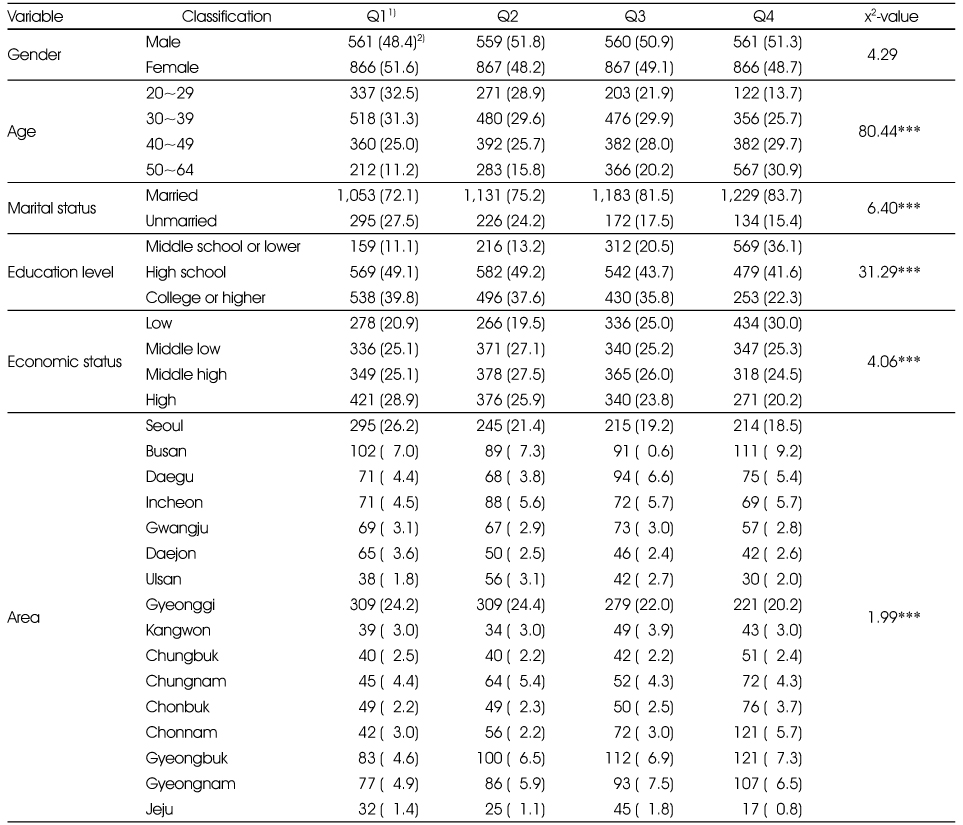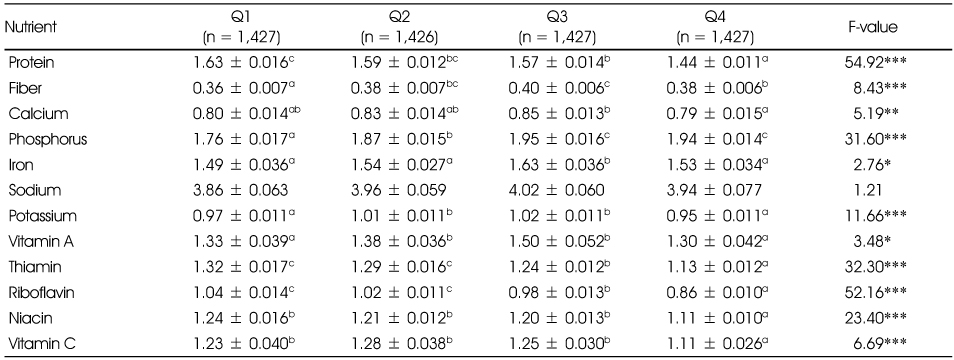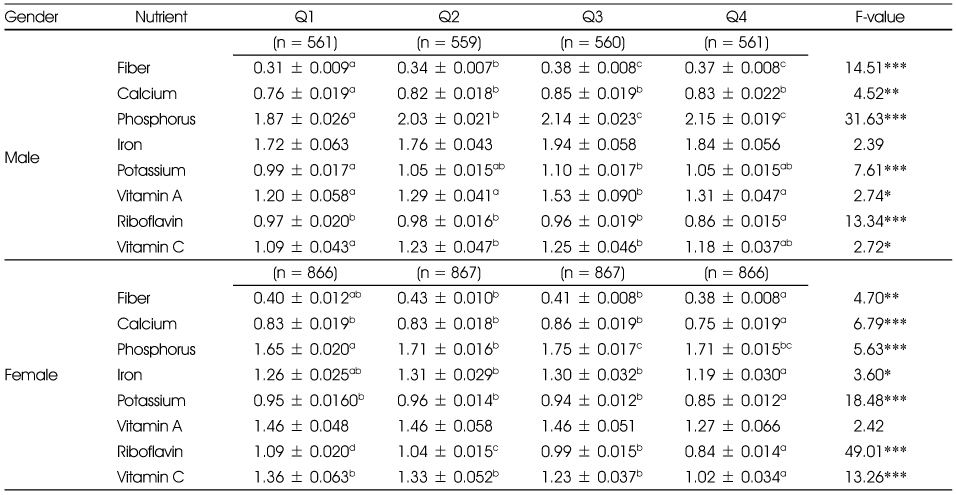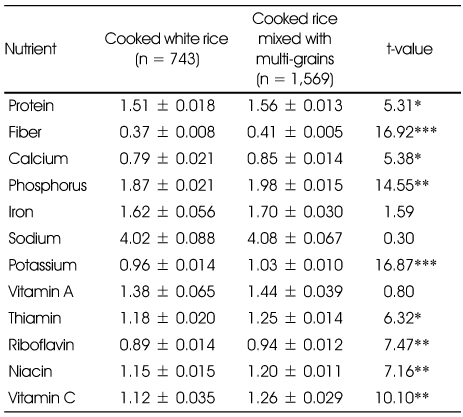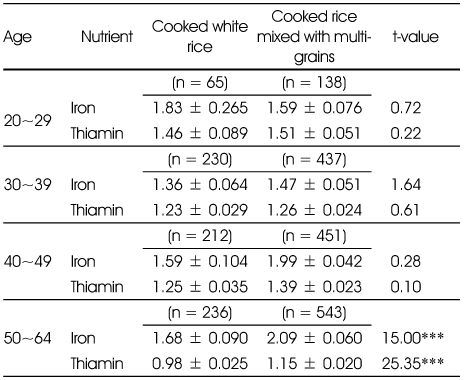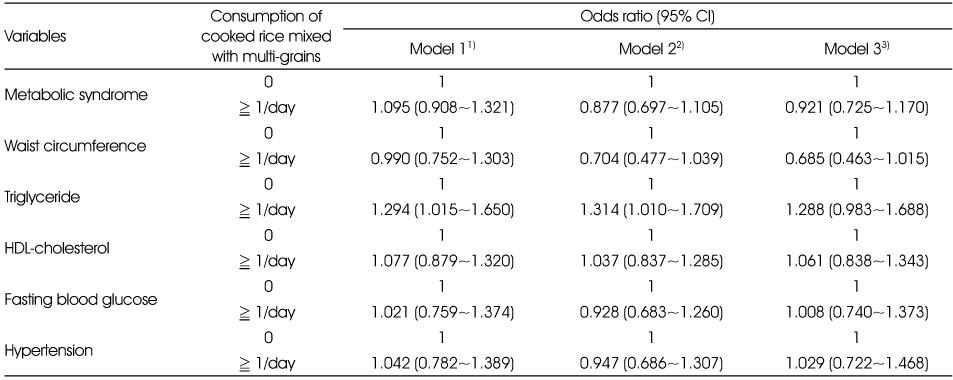References
1. Ahn JY, Ha TY. Nutritional superiority of rice. Food Preserv Process Ind 2010. 9(2)60–62.
2. Baxter AJ, Coyne T, McClintock C. Dietary patterns and metabolic syndrome - a review of epidemiologic evidence. Asia Pac J Clin Nutr 2006. 15(2)134–142.
3. Bland JM, Altman DG. Multiple significance tests: the Bonferroni method. BMJ 1995. 310(6973)170.
4. Cha HM. A study on the trend analysis regarding the riceconsumption of Korean 2010. Woosong University; 96–106.
MS thesis.
5. Eckel RH, Grundy SM, Zimmet PZ. The metabolic syndrome. Lancet 2005. 3651415–1428.
6. Flint AJ, Hu FB, Glynn RJ, Jensen MK, Franz M, Sampson L, Rimm EB. Whole grains and incident hypertension in men. Am J Clin Nutr 2009. 90(3)493–498.
7. Grundy SM, Cleeman JI, Daniels SR, Donato KA, Eckel RH, Franklin BA, Gordon DJ, Krauss RM, Savage PJ, Smith SC Jr, Spertus JA, Costa F. Diagnosis and management of the metabolic syndrome. An American Heart Association/National Heart, Lung, and Blood Institute Scientific Statement. Executive summary. Cardiol Rev 2005. 13(6)322–327.
8. Hansen RG, Wyse BW. Expression of nutrient allowances per 1,000kilocalories. J Am Diet Assoc 1980. 76(3)223–227.
9. Hur IY, Moon HK. A study on the menu patterns of residents in Kangbukgu - Compared by the sex, age and health risk. Korean J Community Nutr 2001. 6(5)809–818.
10. Janssen I, Katzmarzyk PT, Ross R. Waist circumference and not body mass index explains obesity-related health risk. Am J Clin Nutr 2004. 79(3)379–384.
11. Jeong KH, Seo JH, Jeong YJ. Characteristics of soybean hydrolysates prepared with various protease. Korean J Food Preserv 2005. 12(5)460–464.
12. Jung HJ, Song WO, Paik H-Y, Joung H. Dietary characteristics of macronutrient intake and the status of metabolic syndrome among Koreans. Korean J Nutr 2011. 44(2)119–130.
13. Kang JH, Kim KA, Han JS. Korean diet and obesity. J Korean Soc Study Obes 2004. 13(1)34–41.
14. Kang M, Joung H, Lim JH, Lee YS, Song YJ. Secular trend in dietary patterns in a Korean adult population, using the 1998, 2001, and 2005 Korean national health and nutrition examination survey. Korean J Nutr 2011. 44(2)152–161.
15. Kim J, Jo I. Grains, vegetables, and fish dietary pattern is inversely associated with the risk of metabolic syndrome in South Korean adults. J Am Diet Assoc 2011. 1111141–1149.
16. Kim J, Jo I, Joung H. A rice-based traditional dietary pattern is associated with obesity in Korean adults. J Acad Nutr Diet 2012. 112246–253.
17. Kim YO. Changes in health status with the changing patterns of rice consumption among Korean. Food Ind Nutr 2008. 13(2)15–21.
18. Korea Centers for Disease Control and Prevention. Korea Health Statistics 2011: Korea National Health and Nutrition Examination Survey (KNHANES V-2) 2012. 384–386.
19. Korea Health Industry Development Institute. National Food & Nutrition Statistics: based on 2008 Korea National Health and Nutrition Examination Survey I 2010.
20. Kwon Y. A trend analysis regarding the consumption, energy and macronutrient intakes according to the eating out frequency of the adults 2009. Sangmyung University; MS thesis.
21. Lee HJ, Kim YA, Lee HS. Annual changes in the estimated dietary fiber intake of Korean during 1991-2001. Korean J Nutr 2006. 39(6)549–559.
22. Lee MJ, Popkin BM, Kim S. The unique aspect of the nutrition transition in South Korea: the retention of healthfulelements in their traditional diet. Public Health Nutr 2002. 5(1A)197–203.
23. Lee S. Association of whole grain consumption with socio-demographic and eating behavior factors in a Korea population: Based on 2007-2008 Korea National Health and Nutrition Examination Survey. Korean J Community Nutr 2011. 16(3)353–363.
24. Lee SY. A study of the preference and the consumption pattern for rice foods of university students 2009. Graduate School of Education, Daejin University; MS thesis.
25. Lim BO, Lee CJ, Kim JD. Study on immunoregulatory function of dietary fiber. Food Ind Nutr 2004. 9(2)26–30.
26. Liu S, Stampfer MJ, Hu FB, Giovanncci E, Rimm E, Manson JE, Hennekens CH, Willett WC. Whole-grain consumption and risk of coronary heart disease: result from the Nurses Health Study. Am J Clin Nutr 1999. 70(3)412–429.
27. Ministry of Health and Welfare, Korea Centers for Disease Control and Prevention. The fourth Korea National Health and Nutrition Examination Survey (KNHANES IV) 2008.
28. National Cholesterol Education Program, National Heart, Lung, and Blood Institute, National Institute of Health. Third report panel on detection, evaluation, and treatment of high blood cholesterol in adults (Adult treatment panel III) final report. Circulation 2002. 106(25)3143.
29. Park S, Park MS, Ko JA. The association between carbohydrate intake and waist circumference. Korean J Obes 2008. 17(4)175–181.
30. Park SH, Lee KS, Park HY. Dietary carbohydrate intake is associated with cardiovascular disease risk in Korean: Analysis of the third Korea National Health and nutrition Examination Survey (KNHANES III). Int J Cardiol 2010. 139234–240.
31. Randall E, Niohaman MZ, Contant CF. Diet diversity and nutrient intake. J Am Diet Assoc 1985. 85(7)830–836.
32. Rumawas ME, Meigs JB, Dwyer JT, McKeown NM, Jacques PF. Mediterranean-style dietary pattern, reduced risk of metabolic syndrome traits, and incidence in the Framingham Offspring Cohort. Am J Clin Nutr 2009. 901608–1614.
33. Ryu HK. A comparative study on the nutrient content of rice-based and wheat-based meals in Miryang and Daegu. Korean J Community Living Sci 2003. 14(3)31–42.
34. Ryu SH, Jeon YS, Moon JW, Lee YS, Moon GS. Effect of kimchi ingredients to reactive oxygen species in skin cell cytotoxicity. J Korean Soc Food Sci Nutr 1997. 26(6)998–1005.
35. Ryu SH, Moon GS. Antioxidative and antiaging effects of dietary yellow and black soybean in rats. J Korean Soc Food Sci Nutr 2003. 32(4)591–597.
36. Seo JS, Cho SH. Rice-based traditional meal and prevention of chronic diseases. Food Ind Nutr 2008. 13(2)27–33.
37. Sluijs I, van der Schouw YT, van der A DL, Spijkerman AM, Hu FB, Grobbee DE, Beulens JW. Carbohydrate quantity and qualtity and risk of type 2 diabetes in the European prospective investigation into cancer and nutrition-Netherlands (EPIC-NL) study. Am J Clin Nutr 2010. 92905–911.
38. Song SJ, Lee JE, Paik H-Y, Park MS, Song YJ. Dietary pattern based on carbohydrate nutrition are associated with the risk for diabetes and dyslipidemia. Nutr Res Pract 2012. 6(4)349–356.
39. Song Y, Joung H. A traditional Korean dietary pattern and metabolic syndrome abnormalities. Nutr Metab Cardiovasc Dis 2012. 22456–462.
40. Statistics Korea. Household food grain consumption per capita in 2010 2011.
41. Sun Q, Spiegelman D, van Dam RM, Holmes MD, Malik VS, Willett WC, Hu FB. White rice, brown rice, and risk of type 2 diabetes in US men and women. Arch Intern Med 2010. 170(11)961–969.
42. Yang EJ, Chung HK, Kim WY, Kerver JM, Song WO. Carbohydrate intake is associated with diet quality and risk factors for cardiovascular disease in U.S. adults: NHANES III. J Am Coll Nutr 2003. 22(1)71–79.
